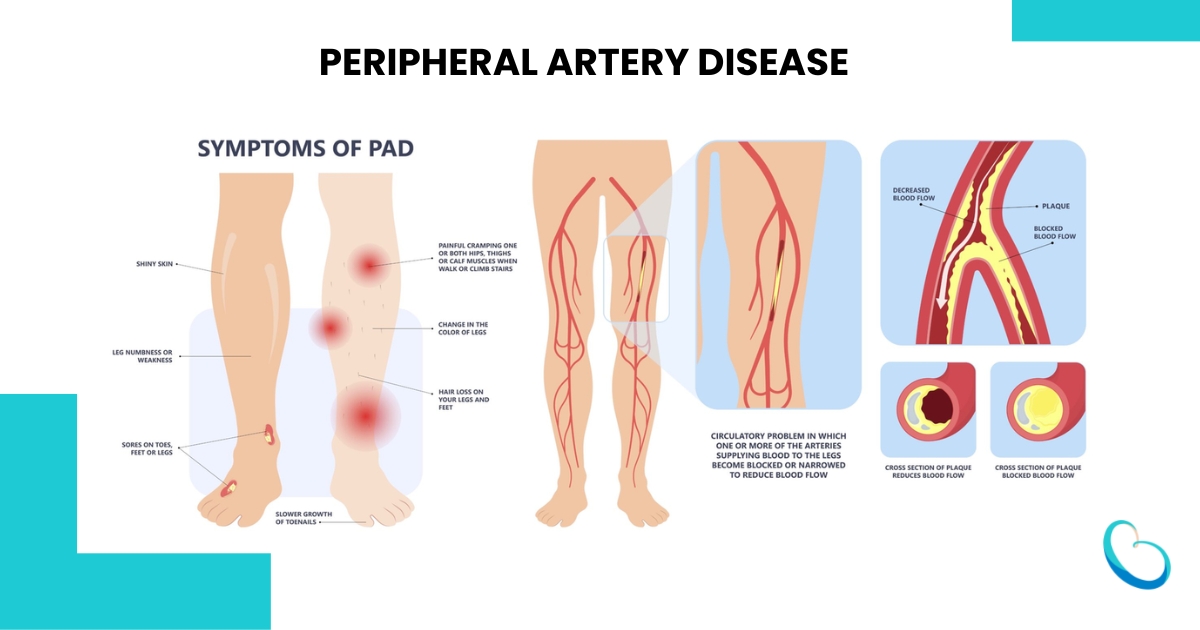Peripheral Arterial Disease (PAD) is a condition in which there is a narrowing or blockage of the arteries that supply blood to the limbs, most commonly the legs. It occurs when fatty deposits called plaque build up inside the walls of the arteries, leading to a reduced blood flow to the affected areas.
The most common symptom of PAD is pain or discomfort in the legs during physical activity, which typically subsides with rest. Other symptoms can include leg numbness or weakness, a burning or tingling sensation, and coldness or discoloration of the skin.
Risk factors for PAD include smoking, diabetes, high blood pressure, high cholesterol, and a family history of the condition. PAD can be diagnosed through a physical exam, ultrasound, or other imaging tests. Treatment options may include lifestyle changes such as exercise and smoking cessation, medications to manage symptoms and reduce the risk of complications, and in severe cases, surgery to remove or bypass the blockage.

Who may need to be evaluated for Peripheral Arterial Disease (PAD):
- People over the age of 50
- Individuals with a history of smoking
- Those with diabetes
- People with high blood pressure
- Individuals with high cholesterol levels
- Individuals with a family history of PAD or cardiovascular disease
- People who have a history of heart disease or stroke
- Those who are obese or overweight
- People who lead a sedentary lifestyle
- Individuals with kidney disease
- People with autoimmune disorders such as rheumatoid arthritis or lupus
If any of these risk factors are present, it may be necessary to screen for PAD to identify the condition and manage any related complications.
What causes Peripheral Arterial Disease (PAD):
- Accumulation of fatty deposits, cholesterol, and other substances in the walls of the arteries (atherosclerosis)
- Smoking
- High blood pressure
- High cholesterol
- Diabetes
- Obesity
- Physical inactivity
- Family history of the disease
- Aging
- Vasculitis (inflammation of the blood vessels) or blood clotting disorders (rarely)
The symptoms of peripheral artery disease (PAD) can vary from person to person, and some individuals may not experience any symptoms at all. However, some common symptoms of PAD include:
- Pain, cramping, or tiredness in the legs or hips, particularly during physical activity or walking (known as claudication)
- Numbness or weakness in the legs
- Coldness in the feet or legs
- Sores or wounds on the toes, feet, or legs that heal slowly or not at all
- A change in the color of the legs
- Shiny or thin skin on the legs
- Weak or absent pulses in the legs or feet
The severity of these symptoms can depend on the extent and location of the arterial blockage. In severe cases, PAD can cause pain or discomfort even while at rest, and it can lead to complications such as tissue damage, infection, or amputation.
It is important to seek medical attention if you experience any of these symptoms or if you have any risk factors for PAD. A healthcare professional can perform diagnostic tests to confirm the presence of PAD and develop a personalized treatment plan to manage the condition and reduce the risk of complications.

What is Peripheral Arterial Disease (PAD Scan)?
A Peripheral Arterial Disease (PAD) vascular scan, also known as a lower extremity arterial Doppler or duplex ultrasound, is a non-invasive diagnostic test that uses ultrasound to evaluate blood flow in the arteries of the legs, arms, or other affected areas.
PAD is a condition in which there is a narrowing or blockage of the arteries that supply blood to the limbs, most commonly the legs. During a PAD scan, a healthcare provider will use an ultrasound machine and a small handheld device called a transducer to produce images of the blood vessels in the affected area. The ultrasound waves are transmitted through the skin and tissues, and bounce back off the blood vessels to create images that show the blood flow through the arteries.
The results of a PAD scan can help to diagnose and evaluate the severity of PAD, which can help healthcare providers develop an appropriate treatment plan. Treatment options may include lifestyle changes such as exercise and smoking cessation, medications to manage symptoms and reduce the risk of complications, and in severe cases, surgery to remove or bypass the blockage.
Overall, a PAD scan is a safe and non-invasive test that can provide valuable information about the health of the arteries in the limbs or other affected areas. It is an important tool in the diagnosis and management of PAD.
Peripheral arterial disease (PAD) can cause painful symptoms such as cramping, numbness, and tingling in the legs and feet. If you are experiencing these symptoms, you may benefit from EECP treatment. EECP is a non-invasive therapy that can improve blood flow to the legs and feet, reducing the symptoms of PAD. By using cuffs that inflate and deflate in sync with your heartbeat, EECP creates a pumping effect that enhances circulation and promotes the development of collateral blood vessels. This helps to reduce pain and improve your ability to walk and engage in other activities. If you have PAD, talk to your healthcare provider about whether EECP treatment may be right for you.







